In 1995 I began treatment for ADHD with a different medicine and the improved concentration led to writing a presentation for SCIET Dynamics. Below is the first attempt. It had been over twenty years since I had begun work on explaining what I had learned. Everything was evolved from visualizations tested by the ``template" and held in visual memory as the entire answer to the question of ``What is the structure of energy?" This is a talking point analysis rather than a persuasive presentation convincing casual web surfers that all the matter and energy in the universe is due to the continuous condensation of its origiinal energy and that the SCIET is the means for this to occur. DMA 2012
A Brief Presentation of a New Mathematical Idea
June 1995
The need for a mathematical tool capable of describing nature in its totality is long-standing. Among the conceptual difficulties are initial assumptions that can create the universe from nothingness, instead of beginning with the existence of particles in space. A system that will do this goes beyond mathematics and into the realm of pure knowledge, confronting cherished beliefs about origins, destinies and all of the mechanisms in between. And clearly, a tool to relate all our experience must simplify while simultaneously allowing all the complexity in the universe. Its clarity will be elegant and to the point.
The effort to discover the structure of energy, or how light stands still, encountered many conceptual problems. Existing terms and metrics, biased toward their original purpose, burden a new explanation with confusing interpretation. Often, new terms are needed to convey the ideas presented here, and they will be explained in the context of that discussion.
Summary
The SCIET is the basic pattern of space. A Single Cycle Integrative Effect Topology is a description of space, whose objective is to freeze change in its most logical standard increment. All things and events are compounds of this.
Measuring the dynamic balance of charge that surrounds a point in space is better called Spacimetry, conveniently sounding like "space symmetry", which is indicative of it's true nature. After all, we are not only measuring space, but energy and time with the SCIET. The complex of assumptions that underlie Single Cycle Integrative Effect Topology start at the beginning of the perceivable universe.
SCIET Dynamics is a system designed to relate the complex of states created by the SCIET, in which everything is based on center to center measurements. This concept was originated by Newton to calculate the effects of gravity. Since SCIET Dynamics can be perceived as a method to quantify gravity, it can be said to be descended from Newton's early work. This theory's intention is to subsume all natural laws.
A good way to understand these concepts is to start with a description of the SCIET as a cyclic charge construct in space in which the idea of polarity moves from obvious to diffuse and back again.
An Internal Infinity
The notion of infinity is inherent to the concept of the point which, similar to Zeno's paradox, can be approached infinitely from all directions. It exists not as a place or thing, but between them, allowing us to approach it only by definition. It represents an internal infinity existing in defiance of our efforts to define smallest or fastest, here or there.
We are left to surround it, choosing the simplest measure , one. From here to there is one unit,(d ) so that without pretense or concern for beside or beyond, we know that the distance between is just one. From one, a series of triangulations can define a tetrahedron, one measure of distance linking four points, equidistant from each other and defining a new point at their center.
Tetrahedron is the most stable definition of Space
The tetrahedron is the defining measure, the first and most stable definition of space in creation. Talk of tetrahedrons suggest shape but we are discussing dynamic balance between points in space. The tetrahedral structure is an essential part of the SCIET's ability to define that balance, not as an independent structure, but as part of a complex of stability that surrounds a point.
Twenty tetrahedrons make a TetraSCIET-a loose version of the fourth Platonic solid, the Icosahedron
Our intention is to model nature. What we observe in nature is limited stability, continuous change within narrow, stable, parameters. The stability of the tetrahedron is offset by its inability to close a set around a point. To illustrate this, take twenty tetrahedrons and join them on a single, shared point. The edges do not fit snugly together, but diverge, forming a loose version of the fourth Pythagorean solid, the Icosahedron. Together, these twenty tetrahedrons account for sixty edges leading away from the center, five at each of the twelve vertices. Each of the triangular faces are separated from one another by a narrow rectangle at the length of the edge and a pentagon at the corners, or vertices. Not an Icosahedron, but twenty tetrahedrons that share a single, central point. This is the first reaction to change in relative position in space, the TetraSCIET. swhich immediately devolves into
The pentagons edge is the defining Sub-unit
It is the vertice-pentagon's edge that defines the systems necessary subunit (s ) which is in a constant relationship with the distance (d ). This is the measure of change that allows stable shifts within all of nature. The SCIET and all of its ramifications depend on this one idea.
The underlying source of circular motion in Nature
A line between any two points now defines a dynamic, adjusting the relationship between them into the space that surrounds them based on the distance and resultant subunit. The stable tetrahedral dynamic is defined by the line between "here and there", an edge of one of the twenty defined stable spaces that surround the center. Therefore, the change is off-center and the adjustment shifts toward the sub-units shared by the edges of the aligning tetrahedron. This causes a pattern of change that moves directionally and this is the underlying source of circular motion in nature.
Phi and the dodecahedron
The fifth sacred solid, the dodecahedron is held within the loose tetraSCIET. The centers of the tetrahedrons, when linked together are the dodecahedron. The distance from the shared center point to the tetrahedron's center is .618 of the tetrahedron's edge.
A Yin to their Yang
The tetrahedral center points, which are the vertices of the internal dodecahedron, are critical to understanding the existence and nature of consciousness. The four points of the tetrahedron share a single center point, a point that represents the balance between them, and must be 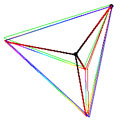 considered a yin to their yang. It is critical to realize that the frequency quality of space is infinite and that concepts of positive and negative, or yin/yang are relative, not absolute. It is better to think of them as frequency states that exist in space as continuing dynamics, with the same kinds of harmonic relationships that we see in sound, the ability to amplify or cancel those that are in their domain. It is this quality that makes the tetrahedral center points important to understanding consciousness. considered a yin to their yang. It is critical to realize that the frequency quality of space is infinite and that concepts of positive and negative, or yin/yang are relative, not absolute. It is better to think of them as frequency states that exist in space as continuing dynamics, with the same kinds of harmonic relationships that we see in sound, the ability to amplify or cancel those that are in their domain. It is this quality that makes the tetrahedral center points important to understanding consciousness.
Begin with all the rules
It seems like a chicken and egg question, to wonder about the beginning of resonance between points and how to calculate the values between them. We are left with only one choice; to assume that the first moment of existence contained all the rules and worked the same as we experience them today.
The Shared Harmonic Resonance
Calculating the value of resonance between two points depends on the starting value of the points. Because each point must be regarded as unique, we consider each to be a prime number. Since we are talking about harmonic frequencies The easiest way to find this is to square each of the primes, add them together and take a square root. The resultant value is certain to be able to interact with both primes. Thus the mid-point value is derived from a formulae used to calculate the hypotenuse of the right triangle, the Pythagorean Theorem. Unlike the geometrical hypotenuse, though, no fractional values are allowed, so the resultant factors are smaller, higher frequency polarity shifts.
The Root of Four Primes
When this idea is applied to the tetrahedral midpoint, the resultant value is the root of four primes rather than two. Since we are talking about harmonic frequencies, values that have the ability to interact with or balance all four primes simultaneously, we are looking at some very high frequency values.
Two Frequency Systems in Balance
The implications of this are important because it means that two systems of frequencies are created by each tetraSCIET. One is the system of equidistant baseline frequency measures and the second, much higher frequency system resonating at the tetrahedron centers, which forms a dodecahedron within the larger tetraSCIET /Icosahedron.
Two Sets of Angularities
The two sets of angularities that are created by these complementary frequency sets represent the simultaneous existence of two chains of consequence, one that is externalizing and another that is internalizing. The number of angularities or vertices in each system, twelve in the externalizing baseline system and twenty in the internalizing mid-point system, are recurrent sets in all natural systems. This insight reveals another idea when systems are regarded as transceivers, broadcasting from twelve angles and receiving with twenty. This suggests that all systems are in a constant pulsing assimilation of information from these spacimetrical frequency domains.
The SCIET number sets are ubiquitous in Nature
These sets are ubiquitous in nature, often being linked in ways that defy conventional explanation. For instance according to Biological Transmutations (1971) by C. Louis Kervran, the transmutation of magnesium and oxygen into calcium involves the integration of eight additional oxygen nucleons with the twelve magnesium nucleons to create the twenty nucleon calcium atom. This feat cannot be explained without a special situation operating in the nucleus. The orientation of the proton/neutron to the center must be involved, shifting the two from an externalizing nature to an internalizing one.
The Baseline can Characterize the Whole System
The baseline, the initial measure defining a system, can be used to characterize the whole system. Since the SCIET is a dynamic existing as a reaction to change, the angle or line between the two points is both the source of change and the result of change. Thus a measure of the baseline can express all the states within the system as a whole. All possible units must be factors of the baseline. This correlates to the metaphysical idea of vibration, as a set of frequency shifts that express the essence of a system or entity.
Begins and Ends with a Singularity
The pulse of a vibration begins and ends with a singularity. Singularity refers to the interval when the system is out of phase with all other systems, existing as one of a kind in the universe. The universe began with a singularity, and this stage is repeated in every cycle. The singularity exists until the system matches phase with another, beginning the resonance frequency reduction that is the start of a new cycle.
tetraSCIET originates with the first matching frequency
The SCIET pattern describes the steps between the singularities. The tetraSCIET originates with the first matching frequency and progresses through all the frequency reductions. As this occurs, the subunit (s ) reduces until it goes out of phase with the base unit of distance, the baseline (d ). When this occurs the base unit is redefined and the process begins again.
Looks like the Yin Yang symbol
The diffusion of polarity within the tetraSCIET matrix, which is the result of the resonance frequency reduction, can be visualized as the progression of the baseline value around the center in increments determined by the Phi ratio. If the polarities could be shaded light and dark and viewed from the top, it would look like the yin yang symbol.
Conclusion
The SCIET relies on observations about the symmetry of the distribution of charge in space, seeking at all times to maintain balance. It is based upon the stability of the tetrahedral relationships that spring from the line between any two points in space. The spatial concept of the tetraSCIET is the starting point to illustrate a method by which change, in the form of charge, is distributed throughout the space defined by the unit of distance between two points in space. It is the complex of stability and dynamic adjustment that form the basis of the mathematical system of SCIET Dynamics
|
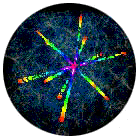
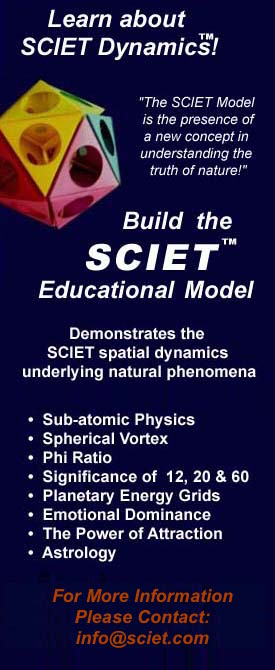

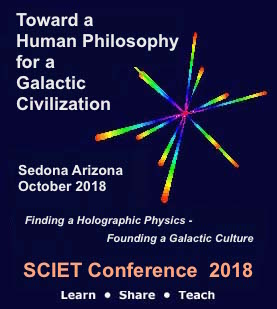
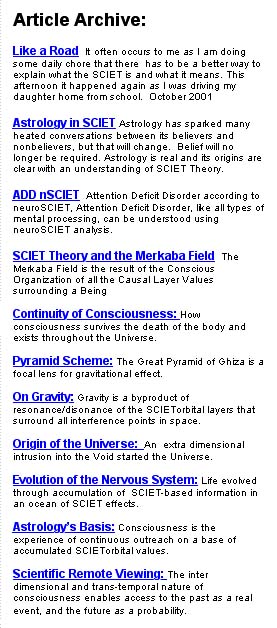
 considered a yin to their yang. It is critical to realize that the frequency quality of space is infinite and that concepts of positive and negative, or yin/yang are relative, not absolute. It is better to think of them as frequency states that exist in space as continuing dynamics, with the same kinds of harmonic relationships that we see in sound, the ability to amplify or cancel those that are in their domain. It is this quality that makes the tetrahedral center points important to understanding consciousness.
considered a yin to their yang. It is critical to realize that the frequency quality of space is infinite and that concepts of positive and negative, or yin/yang are relative, not absolute. It is better to think of them as frequency states that exist in space as continuing dynamics, with the same kinds of harmonic relationships that we see in sound, the ability to amplify or cancel those that are in their domain. It is this quality that makes the tetrahedral center points important to understanding consciousness.